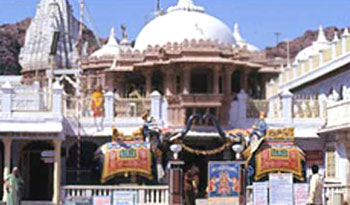 Dhrupad of Nathadvara temple of Rajasthan is a typical example of a Haveli Dhrupad. It has been sung in Raaga Malakaunsa in Chautala. This Raaga is best suited for midnight and belongs to the Bhairavi Thatai and the pentatonic class. All five notes of this Raaga have practically equal importance and melodies may be started with any of these notes. This characteristic offers the performer a comparatively wide field for free improvisation.
Dhrupad of Nathadvara temple of Rajasthan is a typical example of a Haveli Dhrupad. It has been sung in Raaga Malakaunsa in Chautala. This Raaga is best suited for midnight and belongs to the Bhairavi Thatai and the pentatonic class. All five notes of this Raaga have practically equal importance and melodies may be started with any of these notes. This characteristic offers the performer a comparatively wide field for free improvisation.
In the performance of this particular Dhrupad, the Alaap lasts for eight seconds. It begins with middle ni followed by high sa. The singer sings sa for a relatively longer period (by Alanghana) and thereby highlights the importance of this note which is the Samvadi (consonant) of the Raaga. After this he sings dha with a touch of ni, and ni with a touch of dha with feeble mindas. Following this he sings dha again but this time with a touch of ma which he sings with a feeble Gamaka and thereafter he quickly returns to ma where he stays for a short while to emphasize the importance of ma, the Vadi Svara of this Raaga. The whole Alaap is sung in Akara.
Following the Alaap, the singer takes up the composition. He sings Sthayi twice, both times in Thaha (basic rhythm). The first time that the Sthayi is sung, the singer begins in the seventh Matra of the Tala but the second time he starts it with the eighth Matra this means that he must arrive at the Sama in lesser time than before. The commencement with Tara sa is because Raaga Malakaunsa is an Uttaranga Pradhana Raaga (Raaga having predominance of the upper part of the tonal range). The tonal range of the Sthayi both times is from Madhya sa to Tara ma.
After the Sthayi the singer sings Alaap in Akara and then sings Antara twice in Thaha. Each time he commences Antara with Madhya Komala ga and ends it with madhya ma. The first time he begins Antara with the second Matra of the Tala but the second time he begins it with the third Matra of the Tala. In Antara the tonal range is from Madhya ga to Tara ma
After the Antara, the singer sings the Mukhda. It is the opening phrase of the Sthayi. While the singer sings the Mukhda, the Pakhavaj player plays Theka. Once the singer completes Mukhda he becomes silent while the Pakhavaj player goes on to play Parana. After two Avartas of Pardna the player goes back to Theka and the singer now starts singing Sanchari. He sings it twice in Thaha. After Sanchari he sings Abhoga twice in Thaha.
After singing Abhoga for the second time the singer becomes silent, while the Pakhavaj player again plays the Parana. After playing Parana for four Avartas, the player goes back to Theka while the singer first sings Alaap and then the first Dvarta of Abhoga in Thaha. After this he sings the whole Abhoga in Duguna. He commences Abhoga with Madhya Komala Dha and starts it with Sama. The notes of all the four Avartas of Abhoga are different from those which he sang earlier. After this he now sings Antara in Duguna. He commences it with the same note with which he had commenced Antara on earlier occasions. But the melody this time is slightly different. After concluding Antara in the same continuation he sings Mukhda of Sthayi three times and then sings the whole Sthayi in Thaha. The melody of this piece is slightly different from that on earlier occasions. After singing Sthayi the singer becomes silent while the drummer changes from Theka to Parana which he plays for seven Avartas.
Following this, the drum returns to Theka and as he does so the singer begins Alaap. After the Alaapthe singer sings Sanchari in Thaha. The melody of Sanchari is slightly different from previous times. After Sanchari he becomes silent while the drummer plays Parana for only nine Matras. After this the drummer comes back to Theka and as he does so the singer begins Alaap. He sings Alaap for five Matras and thereafter once again takes up Abhoga in Thaha. The melody of Abhoga is different from earlier times.
After the Abhoga finally he sings Sthayi in Thaha. He commences Sthayi with the same note as on previous occasions and also ends it on the same note as on previous occasions. But the melody of the Sthayi is somewhat different from earlier occasions. The end of Sthayi marks the conclusion of the singing.




















